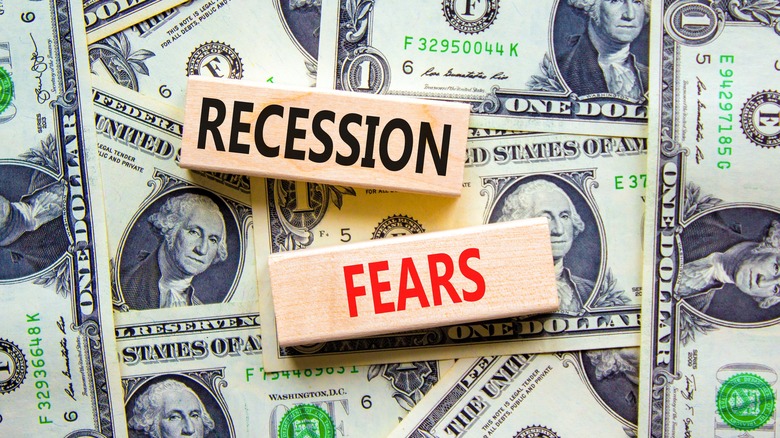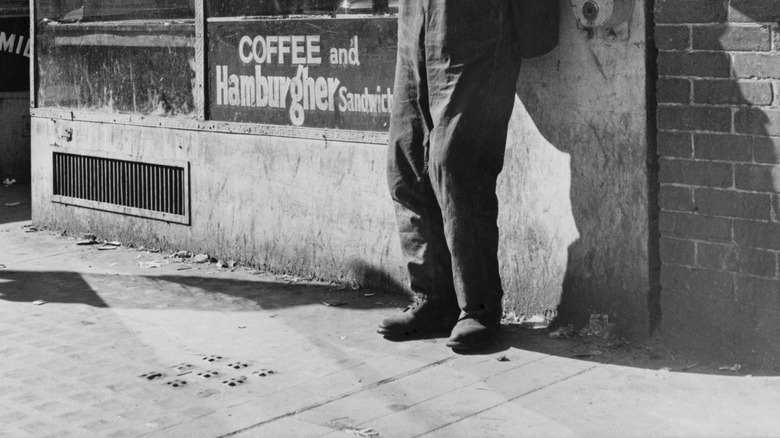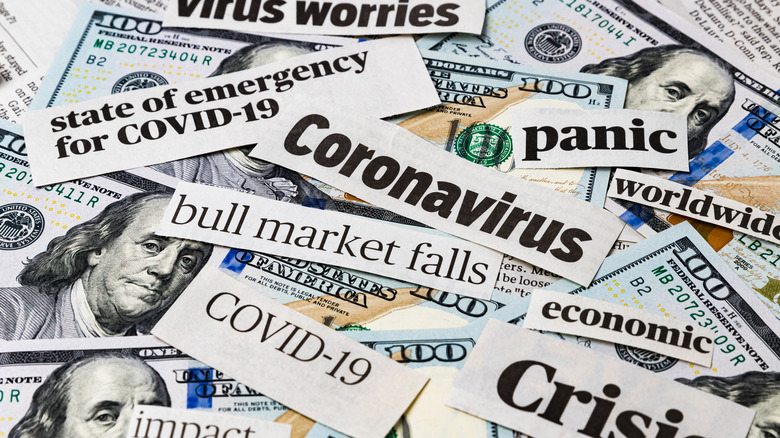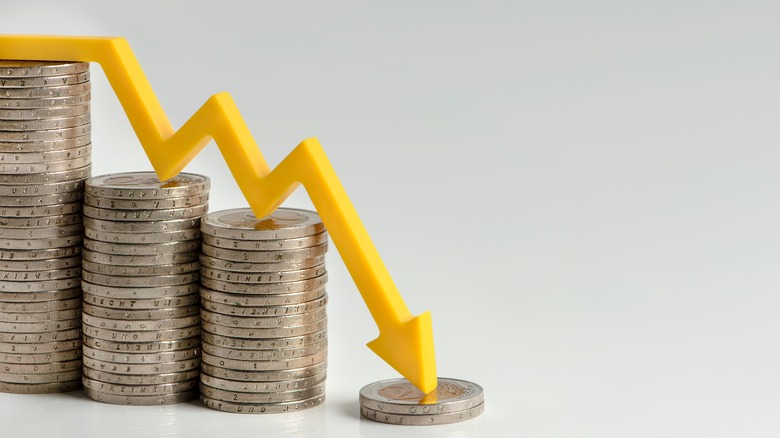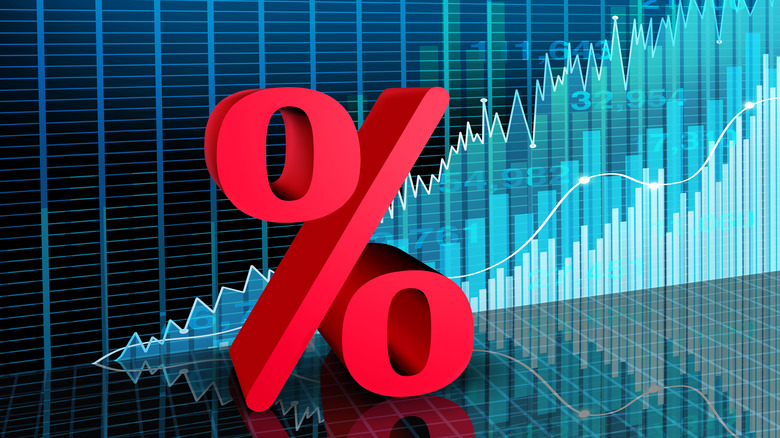What Is A Recession And What Happens During One?
The idea of a recession strikes fear into the hearts of people all over the world. An economic recession is an elongated downturn in the economy on a broad scale, rather than just one sector, according to the National Bureau of Economic Research. Consumers see increased economic stress across the whole of the system over a period of months, or perhaps even years at a time (although the average recession today lasts about 10 months). Recessions can happen for a number of reasons, but typically they are dominated by rising inflation rates and a notable downturn in GDP. What this means in layman's terms is that the dollar weakens dramatically and people stop spending as much money. When consumers as a whole begin to behave in this manner, the market experiences tremendous downward pressure.
In practice, there are a number of classic signs that a recession is on the horizon or already in progress. From a weakening currency to a jump in interest rates, the economics of recession brings about negative market speculation along with weaker spending habits. The good news is, however, that recessions have happened with great regularity in the past and these periods of market pressure and consumer vulnerability come and go. Likewise, a recession is typically found between economic boom periods and so engaging in preparations for the next downturn in the marketplace is something that can be done by anyone.
There is a long history of economic recessions
Perhaps the most famous market downturn happened in the Dutch Tulip market in the 17th century. Market speculation drove the price of tulips to an all-time high, with striped or speckled bulbs commanding roughly the same price as a modest home at the time, according to History. However, it's certainly worth noting that the tulip market crash didn't produce economic ruin across society. Rather, this was a regression to the mean in terms of pricing on a speculative and notably expensive commodity.
More recently, recessions have occurred that shook global markets, including after the dot-com bubble burst of the late '90s and early 2000s, and the housing market crash that took place almost a decade later. These periods of market recession created substantial ripples in the larger U.S. and global economies. For one thing, both happened as a result of marketplace changes in commodities. The housing market crash, in particular, created a substantial fiscal regression because it involved both the financial assets of everyday spenders and the places that they called home.
One thing that's important to remember about any type of market downturn is that this type of economic behavior has happened before, and it will continue to happen long into the future. Even as chaos may take hold of any short-term outlook, there are clear skies looming somewhere in the distance.
Uncertainty, oversupply of goods, and investor speculation
Many different factors typically combine to create a marketplace recession. Scarcity of resources, an extended run on commodity goods that artificially inflate the price, or external factors such as a global pandemic or the outbreak of war can serve as the impetus for a new period of recession.
The stock market crash of 1929 occurred in large part because bank patrons wanted to withdraw their savings all at once as share prices plummeted. When banks ran out of money to provide to their customers, fear and rash decision-making (mixed with agricultural ruin in the Midwest shortly thereafter) would thrust the U.S. and global economies into a period of immense financial depression. During the coronavirus pandemic, a different sort of uncertainty took root and forced consumers to bear the brunt of immense downward market pressure.
Not only did the stock market experience a number of drastic tumbles during the first year of the pandemic's global shutdown, but supply chains were ravaged at every turn as workers became unable to perform their duties and transportation networks experienced an inability to move goods locally and navigated significant barriers to international transport. Many things often combine to thrust an economy into a recession, but one thing that's for sure is the role of speculation and panic in developing an economic downturn.
A recession results from a perfect storm of financial woes
A recession is like a perfect storm of financial, political, and social issues coming together to force an economy to retract from a position of strength. The market fundamentals are clear, but what's less apparent is how these things occur in the first place. Typically, recessions arise out of an overextended market that is then shocked by some kind of external force. In 2022, markets saw a significant retraction as a result of the coronavirus pandemic, supply chain disruptions resulting from it and other factors, and a new war occurring in Eastern Europe that has increased defense spending by nations all across the globe and threatened energy supplies in the process.
The simple truth is that recessions are the complicated mess of factors that come together to create external pressures on everyday workers, investment commodities, and governments. There is typically no single common denominator that's responsible for launching a national or global recession. Rather, a series of evolving threats coalesce to create a challenge to the status quo of the existing marketplace.
Income figures begin to stagnate or even reverse in potency
One of the first signs that a recession is looming is a change in the strength of the dollar, seen most abundantly in wage inflation. Typically, wages rise over the years roughly in line with the inflation rate. Inflation averages out at 3.27% per year, according to YCharts, and so wage increases often mirror or extend beyond this figure. However, during recession periods, inflation may rise to a dramatically higher level, and wage increases simply cannot keep up with this negative change in buying power.
Wage stagnation is an easy-to-notice feature of many recessions. This change can also enrage employees and lead to behaviors that further exacerbate the dire financial circumstances that a community finds itself in. When wages lose pace with inflation, workers feel an immense squeeze on their finances and worker strikes become more likely. This can lead some people to quit their jobs in search of better opportunities, and others to go on strike in pursuit of more equitable treatment by their employers.
These changes in the way that employees behave can further deepen a looming economic crisis. Many parents must stay at home to watch their children rather than go into the office, for example. Similarly, if transportation personnel go on strike, then workers throughout a city must find alternative modes of transit for their daily commutes. Often, these alternative arrangements are more expensive leading to another factor that weakens an employee's earning power.
Consumer spending slows dramatically
During a recession, consumers become hyperaware of problems throughout the economy. Shoppers will often see sparser shelves and increased prices for all kinds of goods. They will also stop spending money freely. One feature could push the other into existence but either scarcity of goods or a dip in consumer sentiment can lead to the other — there is no one-way street in this regard. Furthermore, during a recession, consumers look to hold onto their free cash as tightly as possible. This happens for a number of reasons, but it's generally attributed to the fact that marketplace uncertainty across all segments of consumer spending and income generation shows an unsteady footing. This drives buyers to spend as little as possible in order to maintain security for what might be a potentially worse future, or at the very least, an elongated period of increased costs and economic stress.
Of course, when consumers stop spending money with enthusiasm, local businesses begin to hurt severely and larger corporations feel a squeeze across their operating markets. With a recession that lasts long enough, a dip in consumer spending can drive some businesses to close up shop and others to severely cut back on the products or services that they offer. This leaves a noticeable hole in the marketplace in both the short term and after the market has made a recovery.
Income inequality is exacerbated
Because consumer spending changes so dramatically during a period of recession, and price increases reduce buying power, a recession unevenly impacts consumers across the class divide. Those considered middle-class or upper-class will certainly see a downturn in their ability to spend capital. A recession affects everyone, after all. However, the most negatively impacted are those who live paycheck to paycheck and impoverished families. Similarly, the Economic Policy Institute reports that recessions have a tendency to push people on the fringe of one class segment down into a lower economic rung.
In the same way that Value Added Tax (or sales tax) that's levied against the purchase of everyday goods plays a larger role in spending decisions for low-income earners than higher earners, a sharp rise in prices and this sudden need to incorporate even more careful spending play a much larger role in the daily lives of those with less financial mobility. Generally speaking, buying in bulk allows you to save money on a bevy of different items. As a result, many people try to lump grocery shopping into fewer trips in order to take advantage of fewer individual purchases and greater bulk buying. As prices rise, the impact that this type of practice can make is amplified and yet those with the lowest earnings across the social landscape become even less capable of taking advantage of this essential budgeting tool.
Unemployment typically rises by a marked figure
To make matters even worse, a recession is typically marked by a jump in unemployment rates. With fewer people working, there is less capital flowing through the marketplace and allowing both buyers and sellers to maintain healthy interactions with one another. Of course, there will always be unemployment in society, and the average rate sits at about 6%, according to the Federal Reserve Bank of St. Louis. But when this figure starts to rise, economists become worried that a shift in equilibrium is taking place. Indeed, spikes in unemployment noted on the FRED historical chart track closely alongside times of economic stress.
This type of instability was seen during the coronavirus pandemic when unemployment rates jumped to as high as 13%. With this many people out of work, debts went unpaid, rent went into arrears, and routine spending became far more difficult for a large segment of people. This sudden change affected both homeowners and renters who need to continue paying a relevant third party, and it imperiled routine habits like eating, heating the house, and entertainment. On a macro level, a renter's inability to pay their bill can exacerbate economic uncertainty for a landlord who may be paying a mortgage on the property as well as on their own home.
Manufacturing and industrial production slow considerably
As noted earlier, store shelves grow more desolate during a recession. But this is not solely a result of panic buying. One feature of a recession is a manufacturing sector that has to work to catch up with a change in demand. Naturally, manufacturing processes are somewhat delayed in relation to consumer spending. Retailers purchase goods from manufacturers to sell on the open market, and when consumers stop buying products at expected levels, retailers end up with a surplus of goods in the short term and then revise their purchasing practices with manufacturers. Combined with the typical run on store shelves that happens as markets begin to tumble, there is a delay in purchasing new stock by retailers.
This eventually culminates in scarcity of consumer goods that may last for weeks or even months at a time. Of course, when manufacturing slows down so too does the labor required. As a result, even if unemployment hasn't already spiked, a change in manufacturing needs can directly impact the rate of employment both locally and nationally. If work hours and jobs have remained stable, this can set off a chain reaction; and if a downturn has already been experienced then it can plunge the financial viability of everyday consumers into even greater turmoil.
Even so, Forbes notes that the manufacturing sector often leads the way back out of a period of recession.
Interest rates on new and existing lines of credit increase
During a recession, consumers will also have a harder time borrowing. Central banks might reduce interest rates early on. However, as economic conditions worsen, banks may reverse course and raise rates to combat prolonged economic turmoil.
Rising interest rates force consumers to rethink all kinds of spending decisions that would normally be much simpler. This occurs because mortgage brokers and credit issuers base their rates on federal levels. When a prolonged recession occurs, federal governments begin to consider complex steps to reverse the course. One option is to raise the national rate in an effort to combat the effects of inflation. These increased borrowing rates slow down the economy and create a much more expensive proposition for those looking to buy a new home, car, or utilize a line of credit.
In the same way that uncertainty over job viability contributes to a slowdown in consumer spending, it also forces consumers to rethink their use of credit because repayments may cost more during times of market stress. The housing market can help signal signs of a recession in progress, or one that is deepening. Often, the housing market is a thriving component of a nation's financial health. Buyers are constantly competing to purchase homes that facilitate their needs. But when buyers are hesitant to jump into homeownership or to move from their current property, then it's likely that greater forces are at play.
The cost of living increases
All of this leads to a cost of living crisis for everyday citizens. Goods and services become more expensive, income may be unreliable or in peril, and borrowing products designed to help consumers through expensive purchases or hard times become costlier to utilize. For those who lose their job or see their hours cut, finding alternative resources to supplement their income can be difficult if not impossible. All of these factors force consumers to retreat inward and limit their participation in the marketplace.
One particular choice that homeowners often have to make during times of financial hardship is deciding where they should leverage finite financial resources. A typical budget will combine rent or mortgage payments with savings contributions, gas or electricity bills, internet and TV expenses, groceries, transportation, and new purchasing requirements like clothing for children. During lean times, there may not be enough incoming capital to facilitate all of these expenses, and making hard choices about what to cut must occur. For some families, this choice may be as dramatic as the decision to eat three meals a day or heat the home throughout the winter months (The Guardian notes that 34% and 31% of Britons scaled back their energy and food spending, respectively, in 2022).
Preparing for the worst when times are good can be tough, but must be made done
Financially, socially, and health-wise, a recession creates immense pressure on people from all walks of life. Whether you're a new, young professional living at home or the breadwinner of a single-income family with children, the devastation that recession conditions can bring is equally difficult to manage and is certainly mentally challenging. The decision to slim the budget in order to see this type of financial downturn through can be hectic, but these types of decisions don't have to be devastating.
Recessions will continue to occur. Some may be fleeting and hardly affect your lifestyle, but others will thump you and your community. The best thing that anyone can do is save for a rainy day when times are good. Fidelity reports that you should aim to save 15% of your pre-tax income on a yearly basis. However, it's easy to overlook this advice. Most Americans don't have $1,000 saved to pay for an emergency. If you make saving a part of your routine budgeting, then this can be the first spending item that's cut during a period of financial ruin rather than axing an essential service that you count on. Similarly, the more you save the greater your fiscal buffer will be in the event of a cut to your income. Building a safety net is something that everyone must prioritize, and this practice starts while the market is booming.
